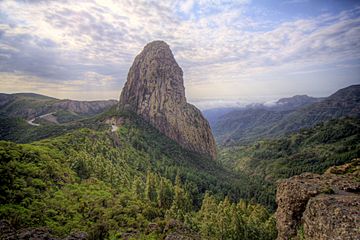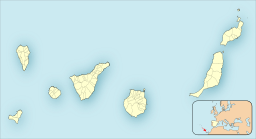Roque de Agando facts for kids
Quick facts for kids Roque de Agando |
|
|---|---|
 |
|
| Highest point | |
| Elevation | 1,250 m (4,100 ft) |
| Prominence | 180 m (590 ft) |
| Geography | |
| Location | La Gomera, Canary Islands, Spain |
Roque de Agando is a very famous rock on the island of La Gomera. This island is part of the Canary Islands in Spain. Many people see Roque de Agando as a symbol of La Gomera because it looks so unique.
What is Roque de Agando?
Roque de Agando is the biggest of a group of special rocks called Los Roques. These rocks are found near the middle of La Gomera island. They are actually what's left of old volcanoes. Imagine a volcano that used to be active. When it stopped erupting, the lava inside the main vent cooled down and became very hard rock. Over millions of years, the softer parts of the volcano around it wore away, leaving just this hard rock core standing tall. That's a volcanic plug!
Other rocks in the Los Roques group include Roque Ojila and Roque Zarcita. Sometimes, Roque Carmona and Roque Las Lajas are also counted in this group.
Easy to See
Roque de Agando stands right next to the main road. This road connects the island's capital, San Sebastián, to Garajonay National Park. Because it's so easy to see from the road, it's a very popular spot for tourists to visit and take pictures.
Visiting Roque de Agando
You cannot walk all the way to the very top of Roque de Agando. In the past, some people used to climb it. They found easy ways to climb the rock. However, climbing is not allowed there anymore.
The area around Roque de Agando is now a protected natural space. This means that visitors must stay on the marked paths. This helps to keep the area safe and protect the natural environment.
Ancient History
Long ago, the native people of La Gomera were called the Guanches. They used the top of Roque de Agando for special ceremonies. They built small shrines there for their rituals. These ancient sites were in good condition for a long time.
Unfortunately, in the 1980s, some of these old shrines were disturbed. Today, efforts are made to protect these important historical sites.
See also
 In Spanish: Roque de Agando para niños
In Spanish: Roque de Agando para niños


